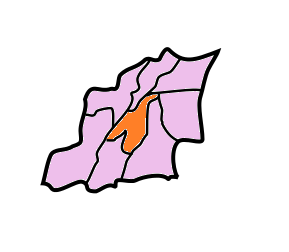|
Ka Likai
Ka Likai is a waterfall in the East Khasi Hills district of Meghalaya State, in north-eastern India. Its river begins in Rangiirteh and passes by the village of Nongriat, though the waterfall can best be seen from the nearby village of Laitkynsew, and the monsoon season in autumn is the most impressive time to view it. Ka Likai is named for a woman from old-time Rangiirteh by the same name, who threw herself into the falls after discovering that her young child by her first husband, had been killed and dismembered by her second husband and then fed to her by him in a curry A curry is a dish with a sauce seasoned with spices, mainly associated with South Asian cuisine. In southern India, leaves from the curry tree may be included. There are many varieties of curry. The choice of spices for each dish in trad .... From that time forward the waterfall was called the Fall of Ka Likai. References East Khasi Hills district Waterfalls of Meghalaya {{waterfall- ... [...More Info...] [...Related Items...] OR: [Wikipedia] [Google] [Baidu] |
Waterfall
A waterfall is a point in a river or stream where water flows over a vertical drop or a series of steep drops. Waterfalls also occur where meltwater drops over the edge of a tabular iceberg or ice shelf. Waterfalls can be formed in several ways, but the most common method of formation is that a river courses over a top layer of resistant bedrock before falling on to softer rock, which Erosion, erodes faster, leading to an increasingly high fall. Waterfalls have been studied for their impact on species living in and around them. Humans have had a distinct relationship with waterfalls for years, travelling to see them, exploring and naming them. They can present formidable barriers to navigation along rivers. Waterfalls are religious sites in many cultures. Since the 18th century they have received increased attention as tourist destinations, sources of hydropower, andparticularly since the mid-20th centuryas subjects of research. Definition and terminology A waterfall is gen ... [...More Info...] [...Related Items...] OR: [Wikipedia] [Google] [Baidu] |
East Khasi Hills District
East Khasi Hills is an administrative district in the state of Meghalaya in India. The district headquarters are located at Shillong. The district occupies an area of 2752 km² and has a population of 825,922 (as of 2011). , it is the most populous district of Meghalaya's 12 districts. History The former Khasi Hills district was divided into East and West Khasi Hills districts on 28 October 1976. On 4 June 1992, East Khasi Hills District was further divided into two administrative districts of East Khasi Hills District and Ri-Bhoi District. Geography Shillong is the district headquarters of East Khasi Hills District. East Khasi Hills District forms a central part of Meghalaya and covers a total geographical area of 2,748 km2. It lies approximately between 25°07" & 25°41" N Lat. And 91°21" & 92°09" E Long. The north of the district is bounded by the plain of Ri-Bhoi District gradually rising to the rolling grasslands of the Shillong Plateau interspersed wit ... [...More Info...] [...Related Items...] OR: [Wikipedia] [Google] [Baidu] |
Meghalaya
Meghalaya (, or , meaning "abode of clouds"; from Sanskrit , "cloud" + , "abode") is a states and union territories of India, state in northeastern India. Meghalaya was formed on 21 January 1972 by carving out two districts from the state of Assam: (a) the United Khasi Hills and Jaintia Hills and (b) the Garo Hills.History of Meghalaya State Government of India Meghalaya was previously part of Assam, but on 21 January 1972, the districts of Khasi, Garo and Jaintia Hills became the new state of Meghalaya. The population of Meghalaya as of 2014 is estimated to be 3,211,474. Meghalaya covers an area of approximately 22,430 square kilometres, with a length-to-breadth ratio of about 3:1.Meghal ... [...More Info...] [...Related Items...] OR: [Wikipedia] [Google] [Baidu] |
India
India, officially the Republic of India (Hindi: ), is a country in South Asia. It is the seventh-largest country by area, the second-most populous country, and the most populous democracy in the world. Bounded by the Indian Ocean on the south, the Arabian Sea on the southwest, and the Bay of Bengal on the southeast, it shares land borders with Pakistan to the west; China, Nepal, and Bhutan to the north; and Bangladesh and Myanmar to the east. In the Indian Ocean, India is in the vicinity of Sri Lanka and the Maldives; its Andaman and Nicobar Islands share a maritime border with Thailand, Myanmar, and Indonesia. Modern humans arrived on the Indian subcontinent from Africa no later than 55,000 years ago., "Y-Chromosome and Mt-DNA data support the colonization of South Asia by modern humans originating in Africa. ... Coalescence dates for most non-European populations average to between 73–55 ka.", "Modern human beings—''Homo sapiens''—originated in Africa. Then, int ... [...More Info...] [...Related Items...] OR: [Wikipedia] [Google] [Baidu] |
River
A river is a natural flowing watercourse, usually freshwater, flowing towards an ocean, sea, lake or another river. In some cases, a river flows into the ground and becomes dry at the end of its course without reaching another body of water. Small rivers can be referred to using names such as Stream#Creek, creek, Stream#Brook, brook, rivulet, and rill. There are no official definitions for the generic term river as applied to Geographical feature, geographic features, although in some countries or communities a stream is defined by its size. Many names for small rivers are specific to geographic location; examples are "run" in some parts of the United States, "Burn (landform), burn" in Scotland and northeast England, and "beck" in northern England. Sometimes a river is defined as being larger than a creek, but not always: the language is vague. Rivers are part of the water cycle. Water generally collects in a river from Precipitation (meteorology), precipitation through a ... [...More Info...] [...Related Items...] OR: [Wikipedia] [Google] [Baidu] |
Nongriat
Nongriat is a village in the East Khasi Hills district of Meghalaya State, in north-eastern India. It is perhaps best known for its living root bridges; one an impressive double-decker suspension bridge called Jingkieng Nongriat. The village has three functional root bridges. These are crafted by hand, as the Khasi people have done in the Khasi Hills for centuries, intertwining and weaving together the aerial roots of banyan trees on opposite sides of a stream-filled gorge. Jingkieng Nongriat, better known simply as ''Double Decker,'' has been featured on international television programs such as the ''Human Planet'' series filmed in 2008 by BBC Wales, and a documentary by Osamu Monden in June 2004 for Asahi TV in Japan. There is another functioning living root bridge upstream from Nongriat, along with a hybrid structure that is made from both roots and steel wire. Near Nongriat, and best viewed from the neighboring village of Laitkynsew during the autumn monsoon ... [...More Info...] [...Related Items...] OR: [Wikipedia] [Google] [Baidu] |
Laitkynsew
Laitkynsew is a village in the East Khasi Hills district of Meghalaya State, in north-eastern India. It is perhaps best known for its living root bridges. The Umnnoi living root bridge, known locally as ''Jingkieng Deingjri'', which means 'bridge of the rubber tree', is 53 feet long and over 100 years old. The Ka Likai waterfall, near the neighboring village of Nongriat, can best be seen from Laitkynsew, and the monsoon A monsoon () is traditionally a seasonal reversing wind accompanied by corresponding changes in precipitation but is now used to describe seasonal changes in atmospheric circulation and precipitation associated with annual latitudinal osci ... season in autumn is the most impressive time to view it. References External links {{Coord missing, Meghalaya Villages in East Khasi Hills district ... [...More Info...] [...Related Items...] OR: [Wikipedia] [Google] [Baidu] |
Monsoon
A monsoon () is traditionally a seasonal reversing wind accompanied by corresponding changes in precipitation but is now used to describe seasonal changes in atmospheric circulation and precipitation associated with annual latitudinal oscillation of the Intertropical Convergence Zone (ITCZ) between its limits to the north and south of the equator. Usually, the term monsoon is used to refer to the rainy phase of a seasonally changing pattern, although technically there is also a dry phase. The term is also sometimes used to describe locally heavy but short-term rains. The major monsoon systems of the world consist of the West African, Asia–Australian, the North American, and South American monsoons. The term was first used in English in British India and neighboring countries to refer to the big seasonal winds blowing from the Bay of Bengal and Arabian Sea in the southwest bringing heavy rainfall to the area. Etymology The etymology of the word monsoon is not wholl ... [...More Info...] [...Related Items...] OR: [Wikipedia] [Google] [Baidu] |
Autumn
Autumn, also known as fall in American English and Canadian English, is one of the four temperate seasons on Earth. Outside the tropics, autumn marks the transition from summer to winter, in September ( Northern Hemisphere) or March ( Southern Hemisphere). Autumn is the season when the duration of daylight becomes noticeably shorter and the temperature cools considerably. Day length decreases and night length increases as the season progresses until the Winter Solstice in December (Northern Hemisphere) and June (Southern Hemisphere). One of its main features in temperate climates is the striking change in colour for the leaves of deciduous trees as they prepare to shed. Date definitions Some cultures regard the autumnal equinox as "mid-autumn", while others with a longer temperature lag treat the equinox as the start of autumn. In the English-speaking world of high latitude countries, autumn traditionally began with Lammas Day and ended around Hallowe'en, the approxima ... [...More Info...] [...Related Items...] OR: [Wikipedia] [Google] [Baidu] |
Curry
A curry is a dish with a sauce seasoned with spices, mainly associated with South Asian cuisine. In southern India, leaves from the curry tree may be included. There are many varieties of curry. The choice of spices for each dish in traditional cuisine depends on regional cultural tradition and personal preferences. Such dishes have names that refer to their ingredients, spicing, and cooking methods. Outside the Indian subcontinent, a curry is a dish from Southeast Asia which uses coconut milk or spice pastes, commonly eaten over rice. Curries may contain fish, meat, poultry, or shellfish, either alone or in combination with vegetables. Others are vegetarian. Dry curries are cooked using small amounts of liquid, which is allowed to evaporate, leaving the other ingredients coated with the spice mixture. Wet curries contain significant amounts of sauce or gravy based on broth, coconut cream or coconut milk, dairy cream or yogurt, or legume purée, sautéed crushed onion, or ... [...More Info...] [...Related Items...] OR: [Wikipedia] [Google] [Baidu] |






